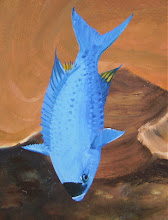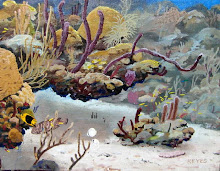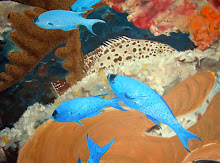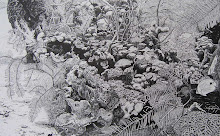.
.
In 2005, the sea became warmer,and warmer until the corals stressed, in an event called bleaching. Coral polyps live with microscopic plants called zooxanthellae (Zoox, for ease) within there bodies. Without the plants, polyps are as clear as glass, and their bones, what we call coral, are snow white.
.
So the living corals on all reefs are the colors of these plants. They can be green, brown, golden, and in many shades and combinations of these colors. If the sea becomes only one or two degrees too hot, the algae dies, and the polyps spit out the ?? compost, and the coral then is a snowy white color. Bleached.
.
Since the corals depend on the plants for food and oxygen, without them, the corals gradually become weak and starved. Sometimes if the sea cools quickly enough in the fall, the corals can adopt(eat) more algae and live. But it's a rough trip. In the year 2005, there was a terrible bleaching event here in the Caribbean, and over 60% of our corals died. Colonies that were here and thriving before Columbus arrived died. Whole areas were devastated. There are some places that I still refuse to go.
.
I was diving a lot that summer, and photographing more than 100 individuals, and filing the photos. It was really depressing to watch helplessly as this happened. To do my self-imposed work, to sort the corals, I named them, Andy, Rosie, Petunia, Pieface. Petunia is still living, as is Pieface.
.
Pieface is in a very easily recognized place, just at the side of the channel that is straight out from the boat ramp in Cane Bay, where you usually turn left to go along the reef. You turn left, they turn left, not me, I turn right.
.
Here's a Bleached photo of the place, and Pieface is the round coral at the right. This is about 90 feet deep, 30m.
.
Ah, blue pictures! The living, bleached corals here are light blue, instead of white, because of the sunlight filtering down through the blue sea, and my camera back then that couldn't balance the blue to white. The darker stuff is all dead substrate, but used to be living.
.
A truly healthy reef has no dead space, it's all life crowded together pushing against and crawing over itself. I've seen that, amazing. Like the black and white pen and ink drawing at the top of this blog. I doubt the Caribbean has any reef like that anymore. That drawing is from Grand Cayman island, 25 years ago.
.
So here is some of my series of Pieface that terrible summer, when the sea all the way to recreational diving depth of 130 feet, 40m, warmed four degrees over the limit for Zooxanthellae life, 86f, 30c
.
.
Pieface survived.
Pieface, first portrait.
.
Beginning to bleach, losing Zoox.
.
October, American dates with the month first. Pieface is mostly bleached. There is some color around the edges. Perhaps this is how Pieface survived. All of the coral shares food eaten and produced by individual polyps.
.
The sea begins to cool in November, and the Zoox spreads Perhaps the spots in the middle are new algaes that the coral has adopted. I believe that, but don't know for sure.
.
And the blue color, once again, should be snowy white, but my camera couldn't see like a human.
.
The end of November, and Pieface is doing well.
.
And here's Pieface about a month ago, 06/23/09. Gorgeous color, and ouch, a hole in his left side. A little silt to deal with.
.
Here's Petunia!
.
Not the greatest photo, but I'll get better, someday, with my photography!
.
OK, have a great day! Thanks for stopping by!
.
.










.jpg)



.jpg)
.jpg)
.jpg)
.jpg)
.jpg)
.jpg)
.jpg)
.jpg)
.jpg)
.jpg)
.jpg)
No comments:
Post a Comment